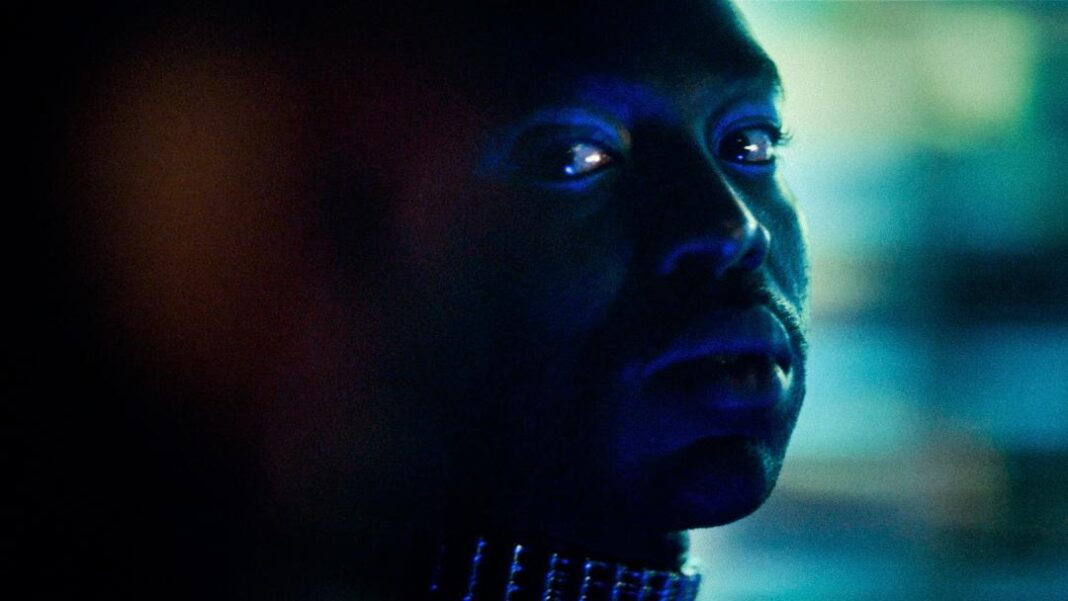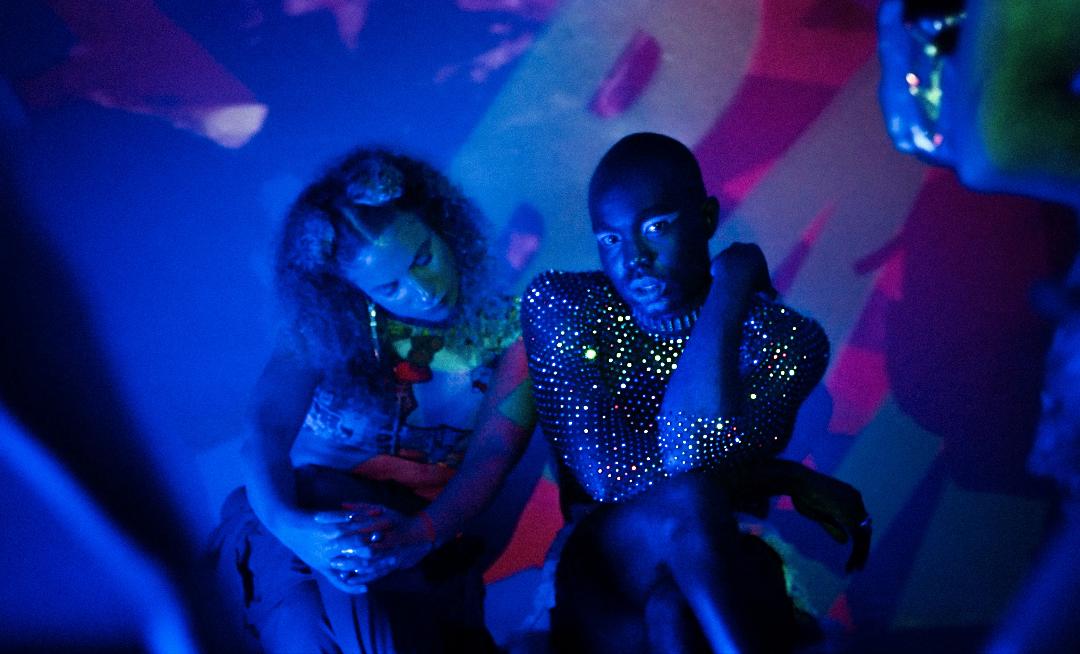Proof that LGBTQ+ narrative-based stories can pack a punch can be seen in full in writer/director duo Sam H. Freeman and Ng Choon Ping’s stunning short film FEMME, which takes a classic London nightlife tale and turns it on its’ head with dividends.
Film And TV Now spoke with the team about this brilliant short.
FILM AND TV NOW: The film subverts much of the tone of previous street-smart London-based offerings that focus on the dark side of London life like Neil Jordan’s MONA LISA. Tell us how the script evolved from concept to final production.
SAM H. FREEMAN: The starting point for the film was Ping and I’s love for neo-noir crime thrillers (specifically we’d just watched and loved the Safdie Bros’ GOOD TIME), alongside our feeling that the inherent hyper-masculinity of the genre often excludes queer protagonists.
We wanted in on the action. We were interested in telling a story about heterophobia – queer fear of exclusively heterosexual environments – and a genre twist of this sort felt like the perfect way to get at it. We initially pitched the film to Agile Films as a feature, and they loved it so much that they offered to produce and finance a proof of concept. So, we went away and wrote the short.
FILM AND TV NOW: How did you two connect initially?
NG CHOON PING: We were housemates for several years. We spent entire summers playing PS4 (well, Sam played, I watched and criticizes) and eating takeaway.
We also have a Dungeons & Dragons group that meets every week. We spend a lot of time watching films and TV together and dissecting them afterwards (not during because Sam cannot STAND people talking during).
We’ve always talked about working together, but with him a screenwriter and me a theatre director, our paths didn’t cross until we final sat down and decided to make a film together.
FILM AND TV NOW: Tell us about your cast.
SHF: Paapa Essiedu and Harris Dickinson were our ‘shoot for the stars’ picks for the roles, and we didn’t truly believe we’d get them to come on board – we just thought “what’s the harm in trying?”.
So, we were over the moon when they both came back and said they connected with the script. Working with actors of their caliber is such a dream because they respond so effortlessly to every note or idea – you can really dive in to subtext and character and storytelling, and they give you something new to get excited about every take.
Once we had the two of them in place, we built out a really fantastic cast to play the supporting roles – there was a really exciting energy on set.
FILM AND TV NOW: Tell us about your production team.
NCP: The brilliant James Rhodes is our DOP. He came on board the evening before the shoot, as our original DOP had to drop out due to COVID, and now we can neither remember nor imagine a time when we do not have him in our lives.
The characterful glittery top you see on Paapa (among other things) is the brainchild of our amazing Costume Designer George Buxton.
FTVN: Where did you shoot and for how long?
SHF: We shot for four days, which was tight. It was all shot in London, and a lot of it in my boyfriend’s house – which saved us a lot in the budget and allowed us a lot of extra time in the space in pre-production.
FTVN: How did you raise finance for the project?
NCP: Agile Films funded the entire thing. We went to them to pitch a feature, they loved the idea, but wanted to test our abilities as directors, hence the short.
FTVN: Agile Films are the production company. Tell us about your working relationship with them.
SHF: We honestly can’t say nice enough things about Agile. They’re an incredible team to work with.
Sam Ritzenberg has such incredible drive and passion to make brilliant film, he leaves no stone unturned and makes you feel like anything is possible.
Hayley Williams is basically a superhero. Myles Payne took a risk on us because he thought we had something exciting to say, and that doesn’t happen often (especially when money needs to be put on the table).
FTVN: One of the striking things about this film is the sheer energy of the camerawork as the story unfolds to its’ shocking conclusion. Tell us about your working relationship with your cinematographer and what the film was shot on.
NCP: We first met James on the first day of the shoot, which was terrifying, but the chemistry among the three of was instant.
Of course, Sam and I had spent months envisioning the film, but it is to James’s credit that he was able to come in cold and immediately absorb our vision, put his own spin on it, and execute it to mutually satisfactory results.
Because we hadn’t had a traditional prep with James, we would arrive on set a couple hours before the shoot started and talked through the scenes for the day. My memory of the shoot was that it felt like we had worked with James for years, and we understood what one another wanted from each beat of the script.
FTVN: LGBTQ+ content is still a very niche market. Where do you feel progress has been made in promoting the virtues of these types of stories and where do you feel work is still needed to be done?
SHF: I think as more queer/queer-inclusive TV shows and films have started to be made – and become hits – people are realising that LGBTQ+ stories are also universal stories. We’re all just human beings, we deal with the same dramas and emotions. Hopefully as the people at the top of the chain see that queer content doesn’t have to hurt their bottom line, the purse strings will continue to loosen.
FTVN: What has been the overall reaction on the festival circuit to the film?
NCP: Really positive! Everyone who talked to us said how edge-of-the-seat the experience was for them, which was what we were going for!
FTVN: The key strength of the film, which we feel is what a lot of people who are keen to see diversity and gender embraced in narrative film-making, is the LGBTQ+ protagonist in a very noir-ish story. What other genre-based narrative stories are you hoping to tell in the future?
SHF: We love a genre piece, and we’re be keen to put our twist on some other genres in the future. Right now, all our plans are focused on the feature version of FEMME.
FTVN: Are there plans to show the film to teenagers and twenty-somethings as a point of reference about the moral implications and consequences of what character is up against in the story?
NCP: We have no specific plans for that, but of course we’d be thrilled if it gets as wide an audience as possible.
FTVN: How has the global challenge of the last two years affected your development and evolution as film-makers?
SHF: It posed challenges for the shoot. Our DOP had to drop out the day before we started filming because she was on another shoot with someone who’d got it and had to quarantine.
It’s also changed the festival experience somewhat as so many festivals had to go digital, and although amazing efforts were put into translating that experience online, a lot of chances to meet people and network were lost.
FTVN: What are your immediate plans for the future?
NCP: We’re making the feature film for which the short was a proof of concept.
FTVN: Finally, what are you proud of about this film, both as individuals and as a creative team?
SHF: I think the thing that I’m most proud of is that people have had a visceral reaction to the film – when someone tells me they gasped and covered their eyes or had to pause to take a breath. Our ambition in making films is always to make.






























